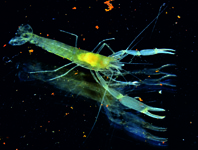Abstract
Benthodytes marianensis sp. nov., is described from the Mariana Trench at the depth of 5567 m. This is the thirteenth species in Benthodytes Théel, 1882. The new species has a broad brim around the body, dark violet skin, 9 pairs of large dorsal papillae with other papillae of equal or smaller size situated elsewhere, forming two zigzag rows, and some minute papillae scattered around the anterior region. Body wall ossicles are rods, crosses with three or four arms and central apophyses, and crosses of an unusual type. Crosses with four arms and central bipartite, tripartite and tetrapartite apophyses and peculiar cross-shaped ossicles with high apophyses ending in two horizontal arms are present in the dorsum. Large rod-shaped ossicles with bipartite apophyses and crosses with three or four arms and rudimentary apophyses are present on the ventrum. B. marianensis is morphologically most similar to B. incerta, but it is distinguished from B. incerta by the number and arrangement of dorsal large papillae, the broad brim and details of ossicle morphology. The phylogenetic analyses based on (16S, COI) and nuclear genes (H3) all confirm the morphological identification.
References
Amin, M.H.F.A., Pidada, I.B.R., Sugiharto, Widyatmoko, J.N. & Irawan, B. (2016) Sea cucumber species identification of family Caudinidae from Surabaya based on morphological and mitochondrial DNA evidence. International Conference & Workshop on Basic & Applied Sciences, 1718, 79–118.
https://doi.org/10.1063/1.4943311Colgan, D.J., McLauchlan, A., Wilson, G.D.F., Livingston, S.P., Edgecombe, G.D., Macaranas, J., Cassis, G. & Gray, M.R. (1998) Molecular phylogenetics of the Arthropoda: relationships based on histone H3 and U2 snRNA DNA sequences. Australian Journal of Zoology, 46, 419–437.
https://doi.org/10.1071/ZO98048Fujikura, K., Okuya, T. & Maruyama, T. (2012) Deep-sea life: Biological observations using research submersibles.Tokai University Publications Association.
Gebruk, A.V. (2008) Holothurians (Holothuroidea, Echinodermata) of the northern Mid-Atlantic Ridge collected by the G.O. Sars MAR-ECO expedition with descriptions of four new species. Marine Biology Research, 4 (1), 48–60.
Gebruk, A.V., Tyler, P.A. & Billett, D.S.M. (1997) Pelagic juveniles of the deep-sea elasipodid holothurians: New records and review. Ophelia, 46, 153–164.
https://doi.org/10.1080/00785326.1997.10432581Hansen, B. (1975) Scientific results of the Danish deep-sea expedition round the world 1950-52. Systematics and biology of the deep-sea holothurians. Part. l. Elasipoda. Galathea Report, 13, 1–262.
Jamieson, A. J., Gebruk, A., Fujii, T. & Solan, M. (2011) Functional effects of the hadal sea cucumber Elpidia atakama (Echinodermata: Holothuroidea, Elasipodida) reflect small-scale patterns of resource availability. Marine Biology, 158, 2695–2703.
https://doi.org/10.1007/s00227-011-1767-7Kerr, A.M., Janies, D.A., Clouse, R.M., Samyn, Y., Kuszak, J. & Kim, J. (2005) Molecular phylogeny of coral-reef sea cucumbers (Holothuriidae: Aspidochirotida) based on 16S mitochondrial ribosomal DNA sequence. Marine Biotechnology, 7, 53–60.
https://doi.org/10.1007/s10126-004-0019-yKuhnz, L.A., Ruhl, H.A., Huffard, C.L. & Smith Junior, K.L. (2014) Rapid changes and long-term cycles in the benthic megafaunal community observed over 24 years in the abyssal northeast Pacific. Progress in Oceanography, 124, 1–11.
https://doi.org/10.1016/j.pocean.2014.04.007Ludwig, H. (1894) The Holothurioidea. Reports on an exploration off the west coasts of Mexico, Central and South America, and off the Galapagos Islands, in charge of Alexander Agassiz, by the U.S. Fish Comission Streamer "Albatross, during 1891. Memoirs of the Museum of Comparative Zoology, Cambridge, 17 (3), 1–183.
Martinez, M.I., Solis-Marin, F.A. & Penchaszadeh, P.E. (2014) Benthodytes violeta, a new species of a deep-sea holothuroid (Elasipodida: Psychropotidae) from Mar del Plata Canyon (south-western Atlantic Ocean). Zootaxa, 3760, 89–95.
Ohshima, H. (1915) Report on the holothurians collected by the United States Steamer "Albatross" in the northwestern Pacific during the summer of 1906. Proceedengs of the United States National Museum, 48, 213–291.
https://doi.org/10.5479/si.00963801.48-2073.213Paolo, M.B., Rodolfo, C. & Myriam, S. (1984) Ecological and genetical survey on two deep-sea holothurians: Benthogone rosea and Benthodytes typica*. Marine Ecology—Progress Series, 15, 275–281.
https://doi.org/10.3354/meps015275Rogacheva, A., Cross, I.A. & Billett, D.S.M. (2009) Psychropotid holothurians (Echinodermata: Holothuroidea: Elasipodida) collected at abyssal depths from around the Crozet Plateau in the Southern Indian Ocean. Zootaxa, 2096, 460–478.
Thel, H. (1882) Report on Holothurioidea. Pt. I. Report of the Scientific Results of the Voyage of H.M.S. Challenger. Zoology, 4 (13), 1–176.
WoRMS (2018) Benthodytes Théel, 1882. Accessed from: http://www.marinespecies.org/aphia.php?p=taxdetails&id=123529 (accessed 31 July 2018)

